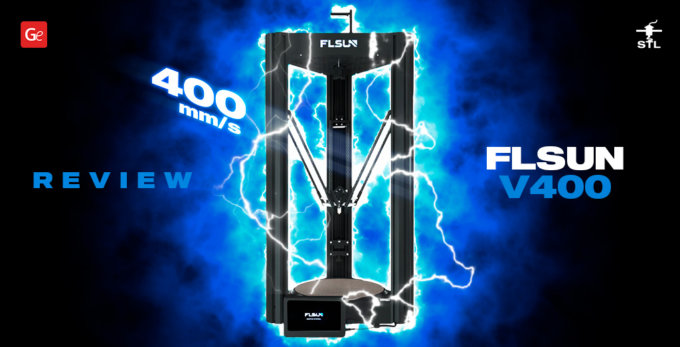One of the most impressive companies in the 3D printing world, Bambu Lab, introduced an affordable “mini” Bambu Lab A1 machine, whose price is close to Anycubic and Creality entries. The Chair of the Engineering Department at Gambody has tested and reviewed the new A1 mini, offering his opinion on this new state-of-the-art desktop machine that can change how you 3D print at home.
Find out what’s inside the box with A1 mini, how it 3D prints, and what extras Bambu Lab offers their customers, along with 3D printers.
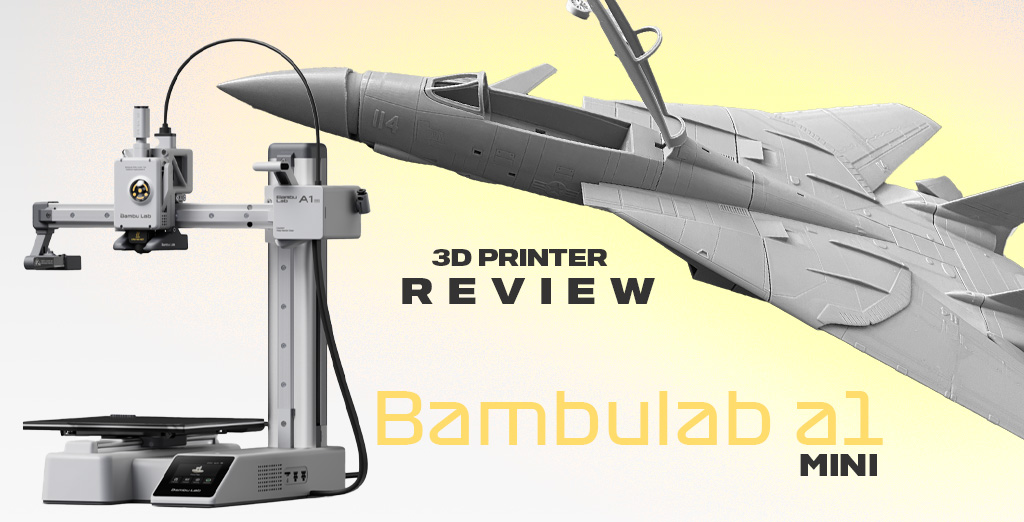
Read also: Stunning 3D Printer Designs 2024
Bambu 3D Printer
Bambu Lab became one of the best home-use 3D printer manufacturers quickly enough, winning customers’ hearts with their price-quality ratio. It was the general concept of the company, not just its AMS multi-colored plastic supply system. Bambu Lab did not follow anyone else. Their engineers, who had recently created DJI, the world’s best camera drone for home use, turned their attention to 3D printing and completely reimagined the machine by designing the first Bambu 3D printer, Lab X1.
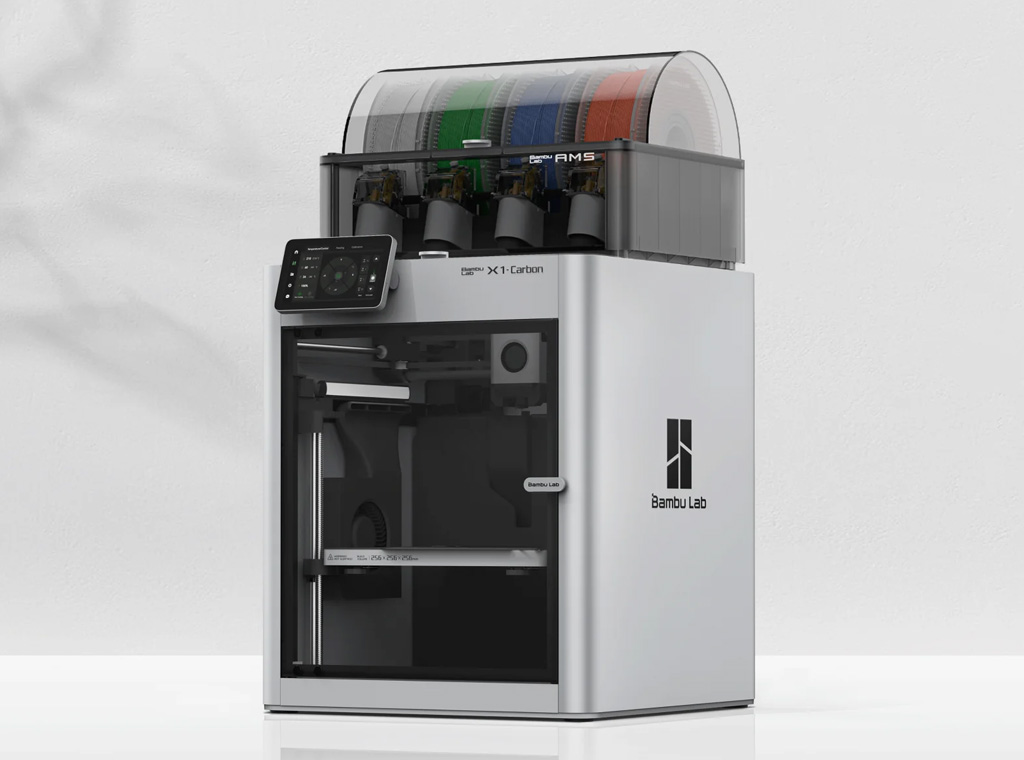
Even before its release, thousands of hobbyists pre-ordered the first Bambu 3D printer through the crowdfunding platform because they trusted the company (DJI), enjoyed a good discount on the Bambu printer, and were wowed by a completely new approach to 3D printing with multi-colored filaments.
Lab X1 boasts many significant advantages, such as an internal fan for creating a uniform temperature environment inside the frame, the ability to print with carbon fiber, a quick-release nozzle, an AMS system, and, of course, excellent print speed and quality. Still, one thing that scared away some customers was the Banby 3D printer’s cost of over 1,700 euros (approximately $1,845). Such an entry price was high, although justified, and not everyone could afford it.
Bambu Lab understood the price concerns and introduced two more 3D printers, P1S and his “stripped brother,” P1P. Engineers removed everything unnecessary, including the Bambu 3D printer walls, leaving only the extruder and kinematics. These machines boast good speed and quality for 700 euros ($760), which is affordable to nearly everyone.
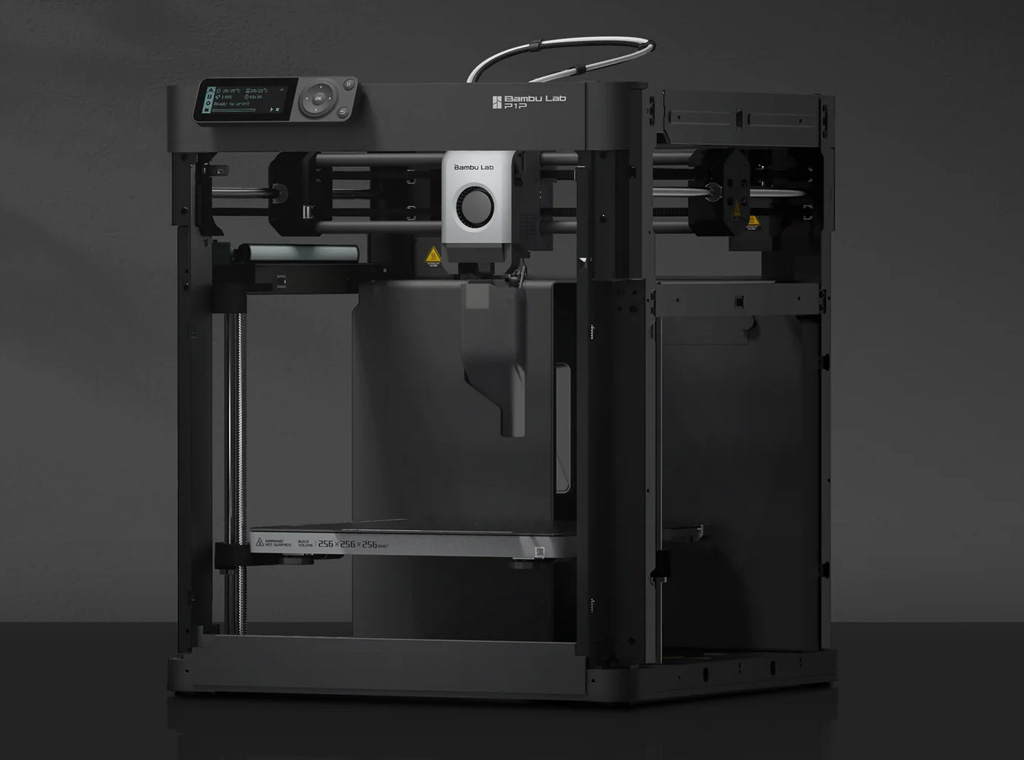
Introducing these three Bambu printer models with the AMS system made Bambu Lab machines very popular among 3D printing enthusiasts. However, Bambu Lab still couldn’t compete with giants like Anycubic and Creality, whose basic 3D printers were $200 to $250, although their print quality was lower.
Bambu A1 Mini
It all changed in the fall of 2023 when Bambu Lab presented its smallest and most affordable A1 mini, originally priced at $299 without or $459 with the AMS system. Recently, the Bambu A1 mini price was reduced by $50, which makes it the most affordable Bambu 3D printer! So, today, you can begin your incredible Bambu Lab 3D printing adventures at just $249, enjoying the impressive print quality and total pleasure.
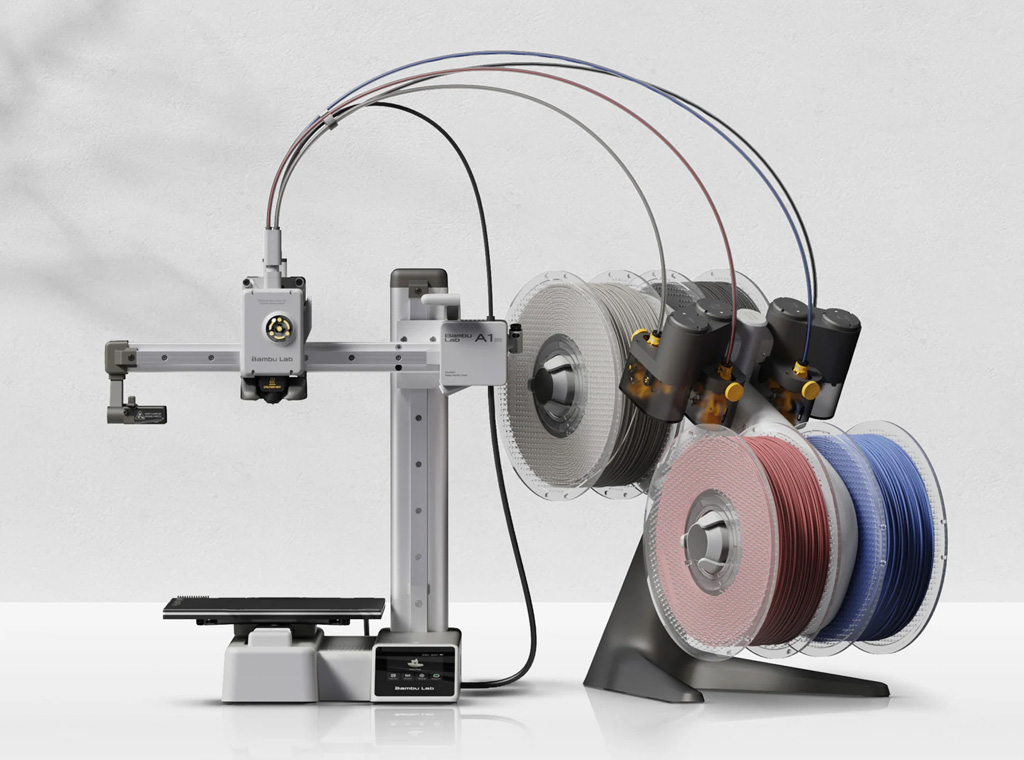
In the Bambu A1 mini, the company abandoned CoreXY kinematics in favor of a railwayman. This helped reduce the final 3D printer cost without compromising the print quality. According to Bambu Lab, its A1 mini prints just as good as its older “brother,” Bambu Lab A1, while its AMS system is quieter, and the design is simply stunning.
Despite its small size, the A1 mini boasts the latest technologies in 3D printing, making it one of the most innovative 3D printers in the hobbyist market. The Bambu Lab A1 mini 3D printer has a chance to become the world’s most popular desktop 3D printer for home use. Therefore, the Engineering Department at Gambody could not pass by the A1 mini without appreciating all its features and sharing its unboxing, review, and testing results with our readers.
Read also: Tips for Increasing Your 3D Printer Speed
A1 Mini Unboxing and Configuration
Although the Bambu Lab A1 mini (the basic version without the AMS system) seems small, it comes in a huge box measuring 380 x 430 x 450 mm (14.9″ x 16.9″ x 17.7″) and weighing about 12 kg (over 26 lbs). The machine with the AMS system will be larger.
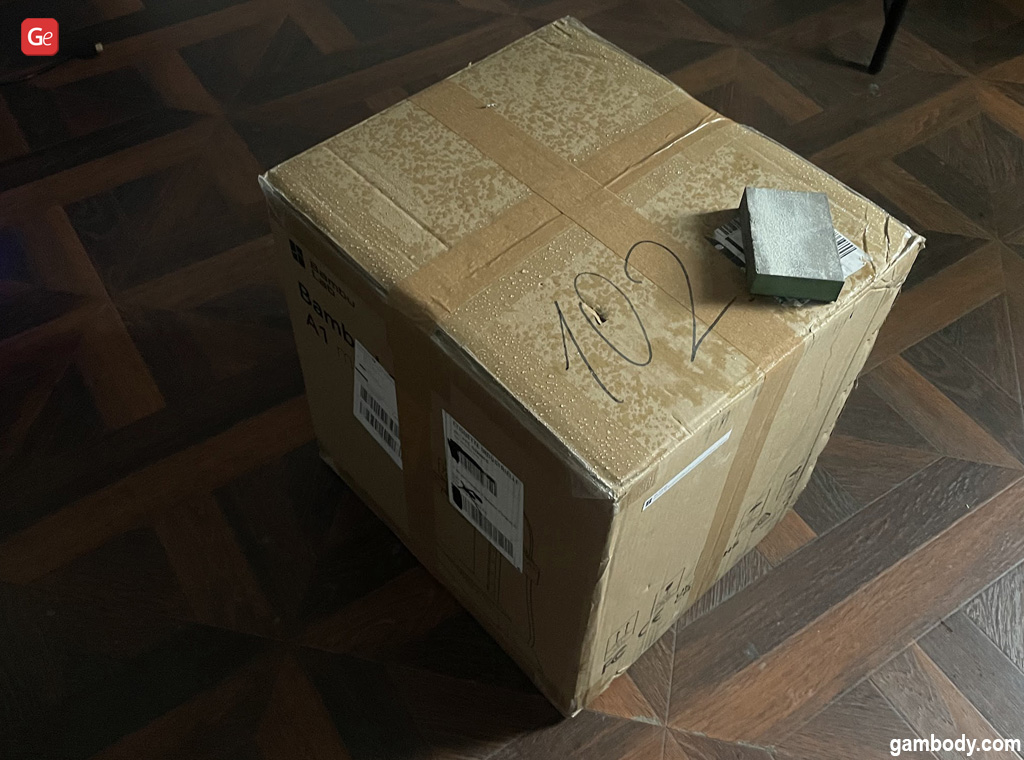
The mini Bambu Lab A1 arrives assembled. You need to unbox it, and it is ready to run. I consider this a huge bonus! If you are new to 3D printing, the manufacturer leaves you no room for error and takes care of all the A1 mini assembly work.
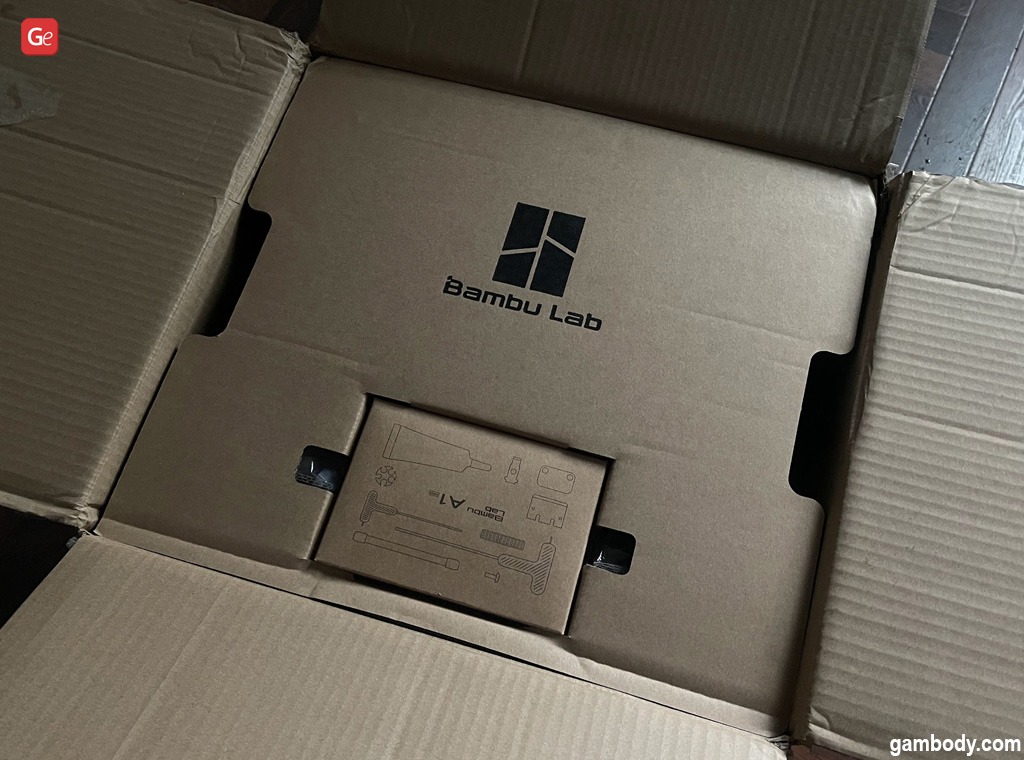
As you open the box, you first see a craft cardboard cover with the Bambu Lab logo. Inside, you can find a box with 3D printer accessories, including several branded assembly tools, lubricant, bagged screws with tags, a blade, and several plastic elements. The kit includes no extra nozzles or filament tongs, so if you need these items, you should order them along with your Bambu Lab A1 mini 3D printer.
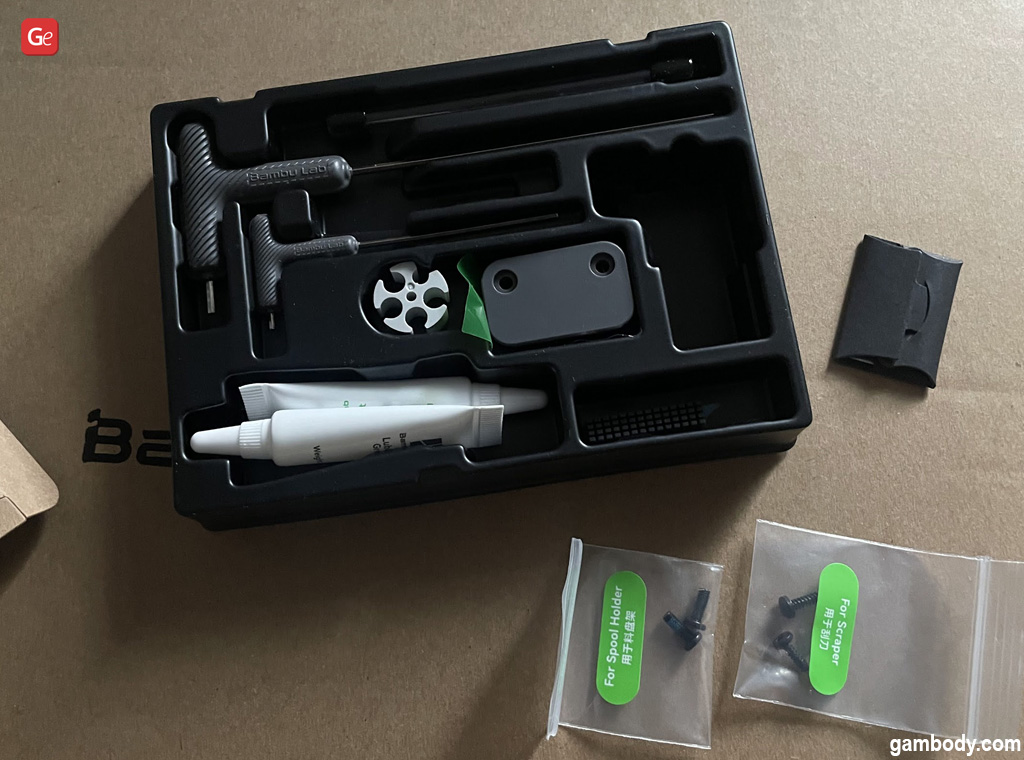
Remove the protective cardboard, and your A1 mini is ready to be taken out of the box. Oh yes, it’s very heavy despite its small size! It looks almost finished. Besides the 3D printer, you’ll find instructions and a small spool of Bambu Lab white filament.
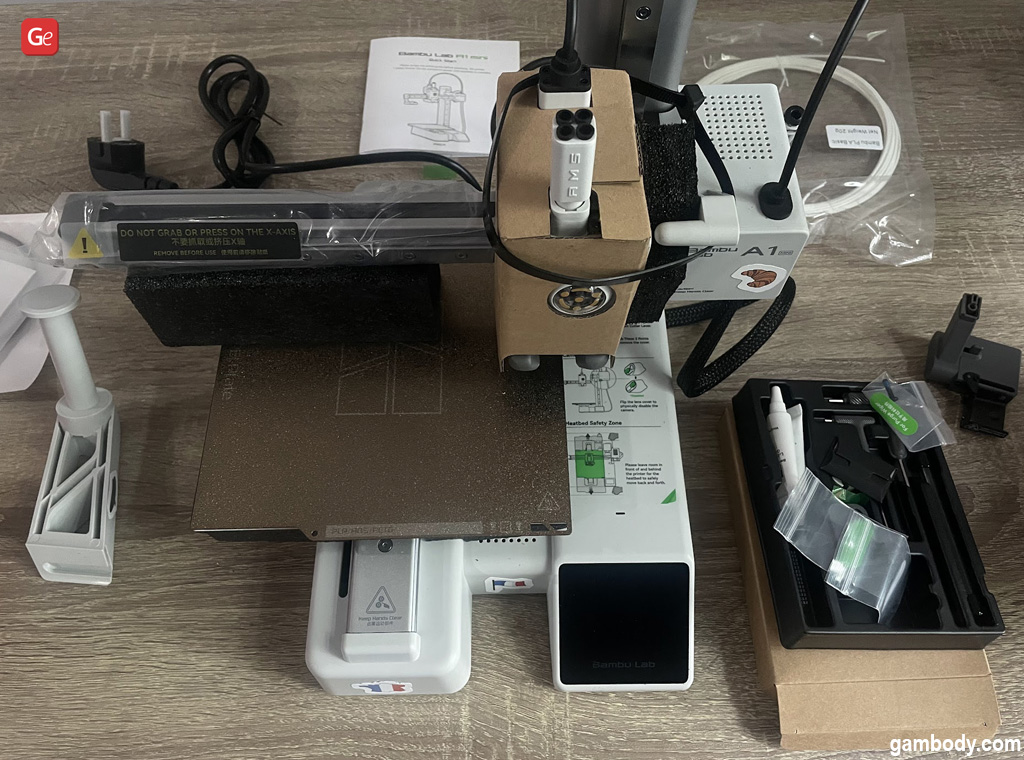
A list of everything you’ll find inside the box with the Bambu 3D printer:
- Filament holder;
- Filament cleaner;
- Bowden tube;
- Filament sample;
- PEI plate;
- Instructions;
- Box with tools.
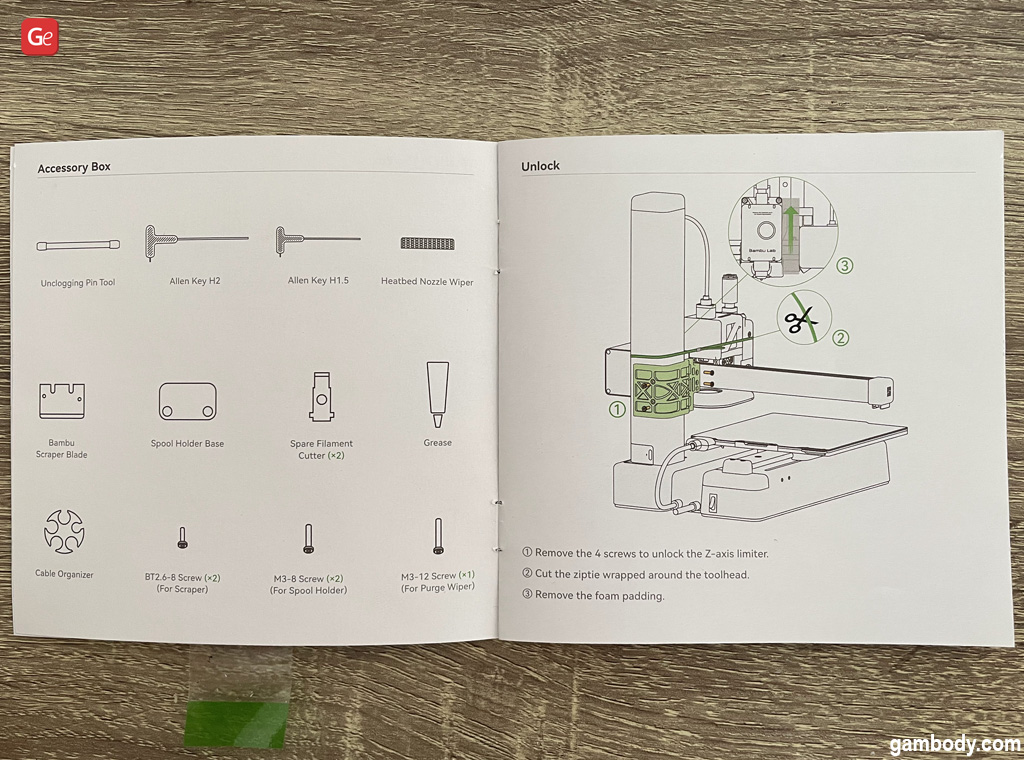
The Bambu Lab A1 printhead is wrapped in a cardboard box and bolted to the Z and X-axis with special technical fasteners, which must be removed and replaced with the filament holder. The bed is secured along the Y-axis with zip ties, which must also be removed.
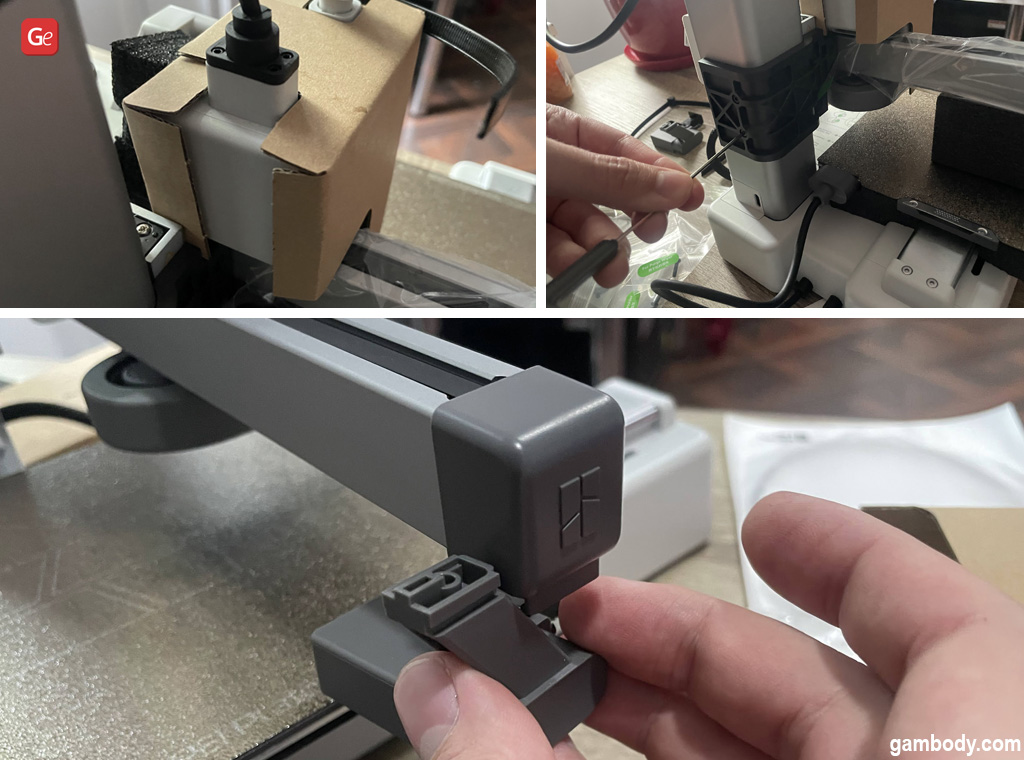
When you assemble the Bambu A1 mini, install a nozzle cleaner at the end of the Y-axis (it’s the first time I’ve seen such a special device). All that remains is to connect the Bambu mini to your network and press the power button.
Read also: Tips for Cleaning 3D Printer Nozzles at Home
Bambu Lab A1 Mini 3D Printer: First Impressions
The Bambu 3D printer looks simply incredible right out of the box. The combination of high-quality light gray plastic with anodized aluminum evokes only positive emotions, and the attention of Bambu Lab to detail is mesmerizing.
The company adds a corporate logo on almost all of its parts, starting from the PEI plate and ending with branded tools. The manufacturer’s attitude to various little details, such as the fixing paste on each screw, also deserves attention. You can’t help but go back to your childhood memories when you just bought a new LEGO set.
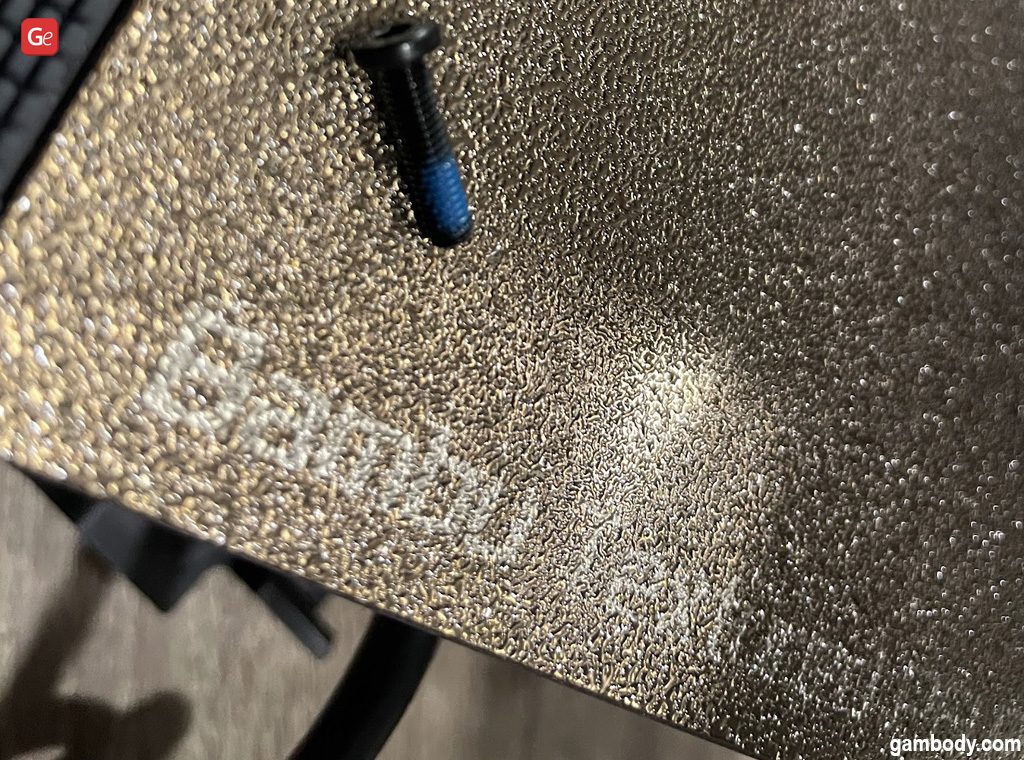
A1 Mini Bambu Features
Let’s take a closer look at the A1 mini 3D printer features offered by Bambu Lab.
1. Print Area
When you look at the mini Bambu 3D printer, the first thing that comes to mind is that the Bambu A1 mini has the same print area as its competitor, Prusa Mini: 180 x 180 x 180 mm (7.08″ x 7.08″ x 7.08″).
You might have heard that such a small print area is not enough for full-scale 3D printing. I have to say right away that our experience proves this falsehood. In fact, the Bambu Lab A1 mini will easily fit 70% to 80% of the model parts. Besides, when Gambody moderates a 3D printing model, our engineers do their best to divide the model into the parts that fit in the exact dimensions of 180 x 180 x 180 mm (7.08″ x 7.08″ x 7.08″). The exceptions are big projects with a large scale, where some parts may not fit due to their size.
Don’t get discouraged by the Bambu A1 mini print area. To be honest, I am impressed by such small 3D printers. When every inch matters in a small apartment in modern megapolises, the A1 mini 3D printer can easily fit on any desk.
2. Printhead
The Bambu 3D printer comes with a direct extruder with a pre-installed AMS lite. In other words, you can order Bambu Lab A1 mini without the AMS system and purchase it later. The nozzle has already been adapted for AMS. It has four inputs for multi-colored filaments.
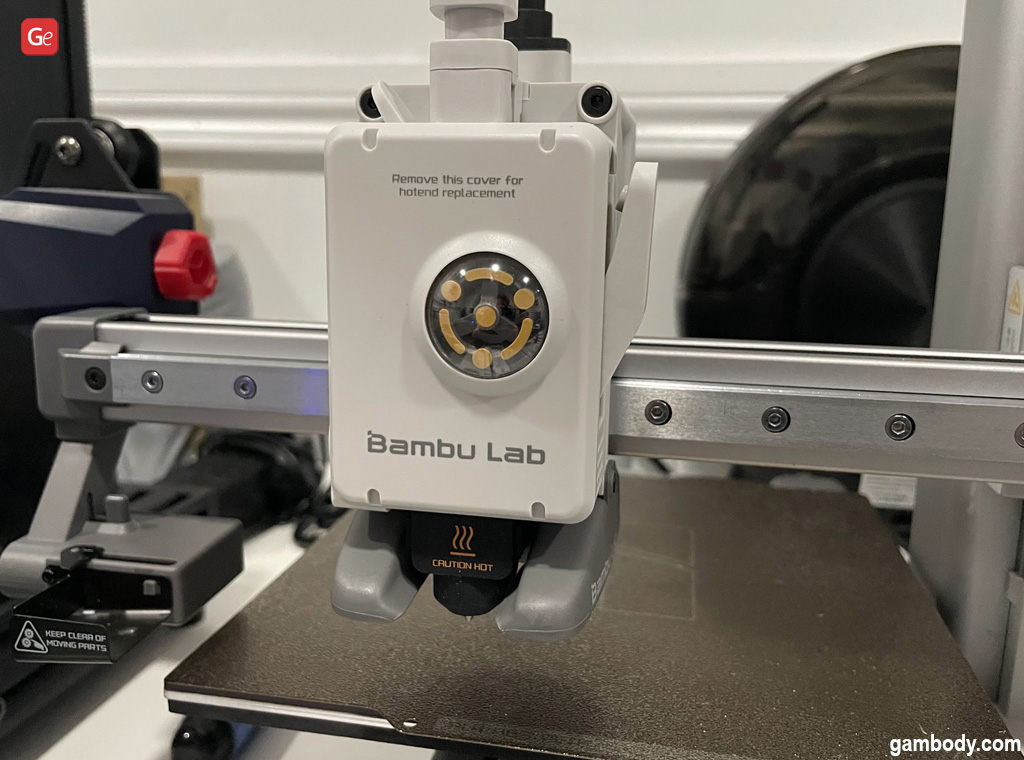
The A1 mini Bambu nozzle design is very unusual and attractive. Engineers moved the cooling fan from the front to the back and placed a plastic filament indicator on the front, which is super convenient! In addition, the A1 mini Bambu 3D printer has quick-release nozzles that are easy to change. The nozzle diameter included with the A1 mini is 0.4 mm, but you can also purchase a nozzle of a different diameter (0.2 mm or 0.1 mm) and replace it.
The nozzle can heat up to 300 °C, which allows Bambu Lab’s new printer to print PLA, PETG, TPU, PVA, and similar filaments.
Read also: How to Change Nozzle on 3D Printer from 0.4 mm to 0.8 mm
3. Heated Bed
The Bambu A1 mini has a familiar PEI plate, which allows 3D printing without adhesives. The bed has a brand logo and its own name (Bambu Lab offers several different plates on their website).

In addition, the heated bed features an innovative system for cleaning plastics and calibrating itself. We have already seen something similar on the Anycubic Kobra 2 3D printer. However, Bambu Lab engineers went further and used a silicone brush instead of a silicone disk; this mechanism cleans the nozzle even better and calibrates it. The bed’s maximum heating temperature is 80°C.
4. Bambu Mini Kinematics
A1 mini features CoreXZ kinematics, while the X-axis has only one-side support, like in Prusa MINI. Such a structure reduces the 3D printer cost, but it also increases the assembly requirements from an engineering point of view.
According to Bambu Lab, the Bambu mini can print at up to 500 mm/sec. It sounds so awesome! The A1 mini 3D printer moves along its axes on high-precision rail guides to ensure accurate positioning and high-quality results. The increased machine weight eliminates unnecessary vibrations. At first glance, Bambu Lab’s new printer is of high quality with nothing loose.
5. Interface
Although the Bambu A1 mini has a standard SD card port, the manufacturer pays great attention to the web interface. I’ve never taken a card out of this 3D printer. Everything is adjusted over the network, and it is very comfortable.
Bambu mini has a default Wi-Fi module. In addition, the A1 mini 3D printer has a mobile application for your smartphone, which lets you monitor the 3D printing process through the phone camera. You can even control your Bambu mini via your phone! You got it right, this is incredible!
6. Slicer
When you order Bambu A1 mini, you are fully immersed in Bambu Lab’s incredible infrastructure and philosophy. You receive a high-quality 3D printer, plastics, and a slicer with optimal settings specifically for your machine. I think this is an excellent solution!
Do you remember how well Cura is adapted specifically for Ultimaker 3D printers and Prusa Slicer is perfect for Prusa 3D printers? We see the same thing with Bambu Studio as the Bambu Lab hardware and software go hand in hand. Therefore, if we offer any slicer recommendations, they will be minimal. Besides, the Bambu slicer can be used with other 3D printers, and we will definitely test it.
Read also: Free 3D Printing Software
A1 Mini 3D Printer Launch and Calibration
Once you assemble and start your Bambu 3D printer, it will make a funny sound that reminds me of a Japanese retro video game melody. Immediately after this, Bambu 1A mini requires you to connect it to the network and then requests you to update its firmware to the latest version.
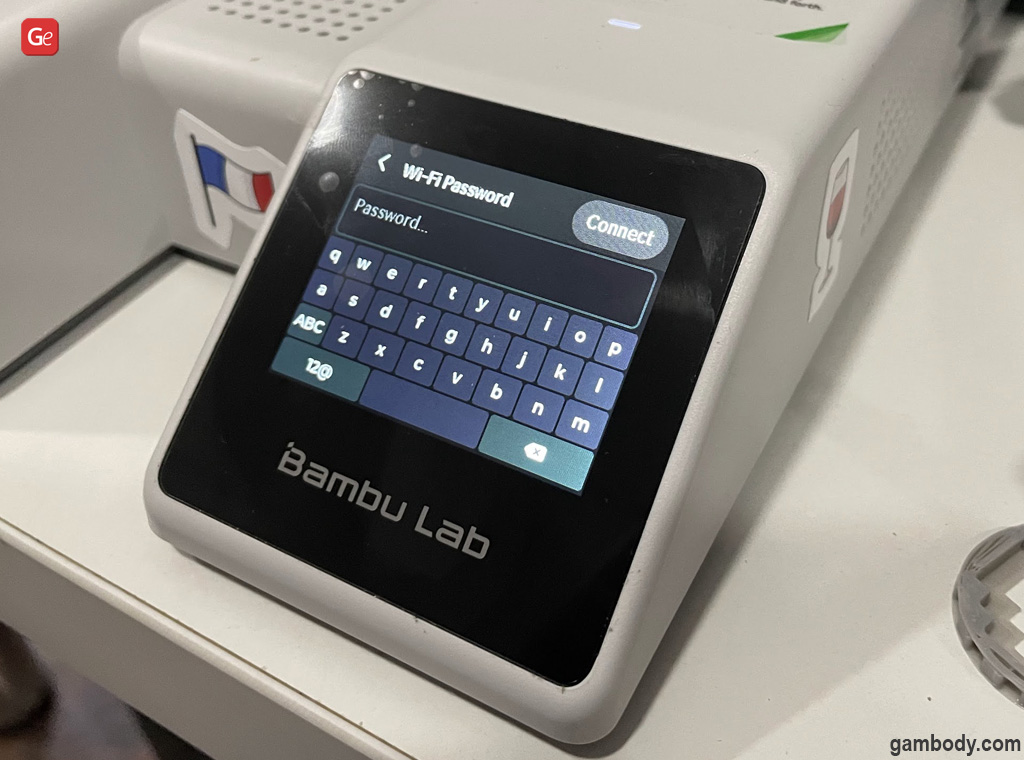
The next step is to calibrate your Bambu Lab A1 mini 3D printer, which offers automatic calibration of its nozzle height above the bed, the bed itself, and the jerk and acceleration speeds. The Bambu A1 mini calibration takes about 5 minutes which is longer than it takes other 3D printers. Still, watching how the Bambu Lab printer cleans its nozzle several times and moves at great speed is a pleasure. It’s very nice and important that the company devoted so much time to the calibration process. You, as a user, have nothing to do but safely observe the whole process.
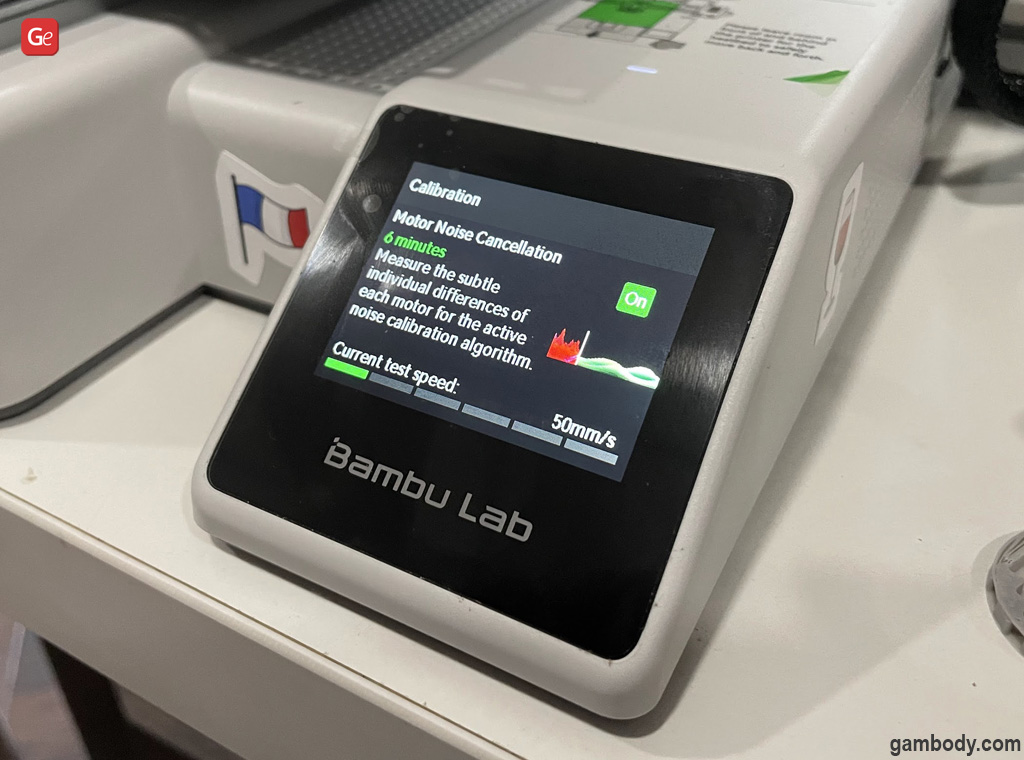
The plastic cleaning system is also very impressive. The Bambu 3D printer moves along the X-axis to the furthest point on the left and extrudes the filament into a special basket. Then a special spatula removes this plastic.
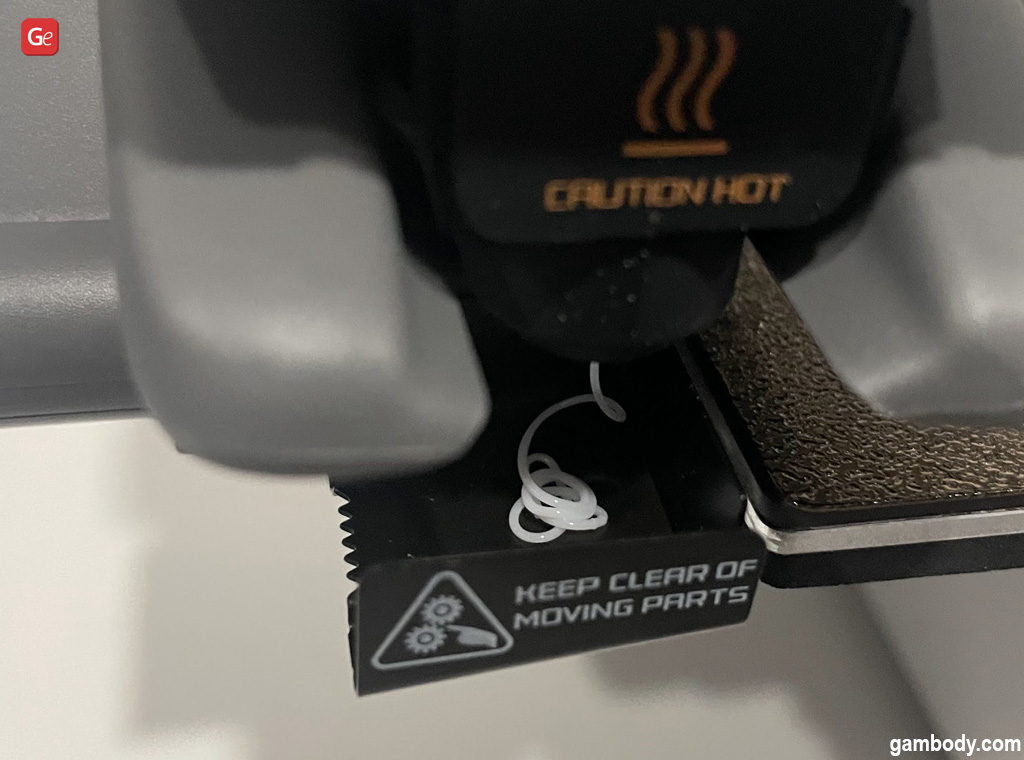
The A1 mini comes with a pre-installed flash drive that contains several testing files you can 3D print. The Bambu Lab printer’s interface is designed to show you a preview of everything you print. Can you imagine this cool feature available in a $250 3D printer? The first thing you’ll notice is the famous #3DBenchy test. You’ll be amazed at how fast the Bambu Lab A1 mini prints this boat (an incredible 15 minutes!), and I am pleased with the quality. The first layer is laid out evenly and adheres well.
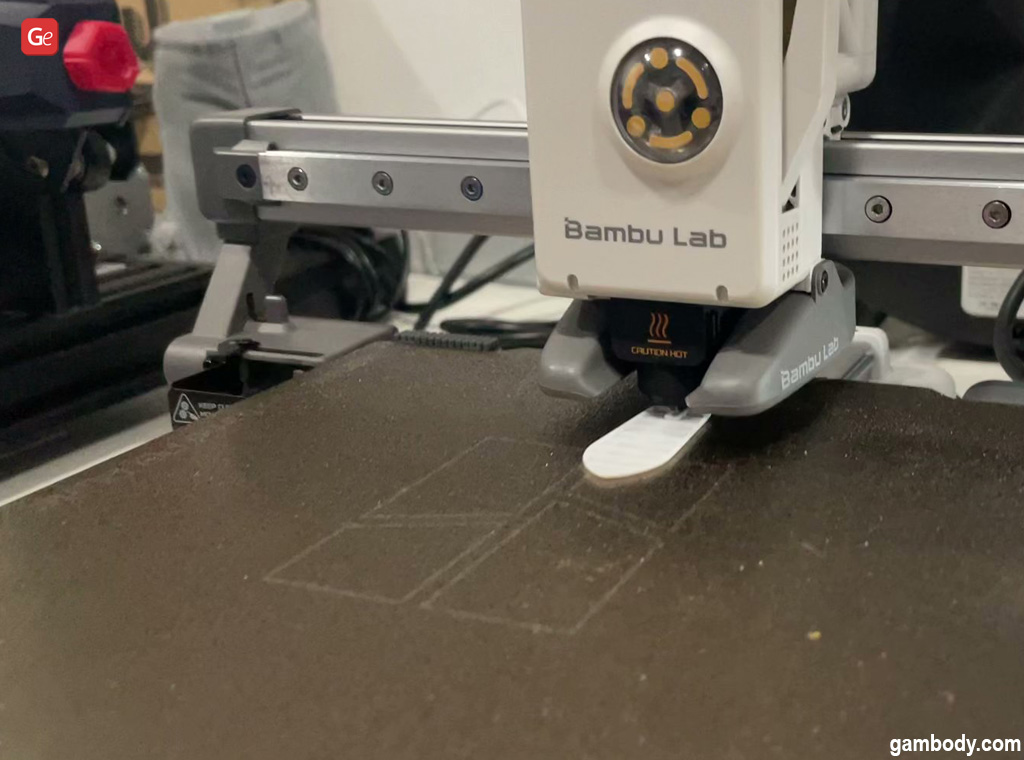
Among other useful 3D printing gadget models, the flash drive also offers a 3D printing file of a handle for the blade that comes with your Bambu 3D printer. 3D print this handle, and you will have a convenient branded scraper for removing the 3D printed parts!
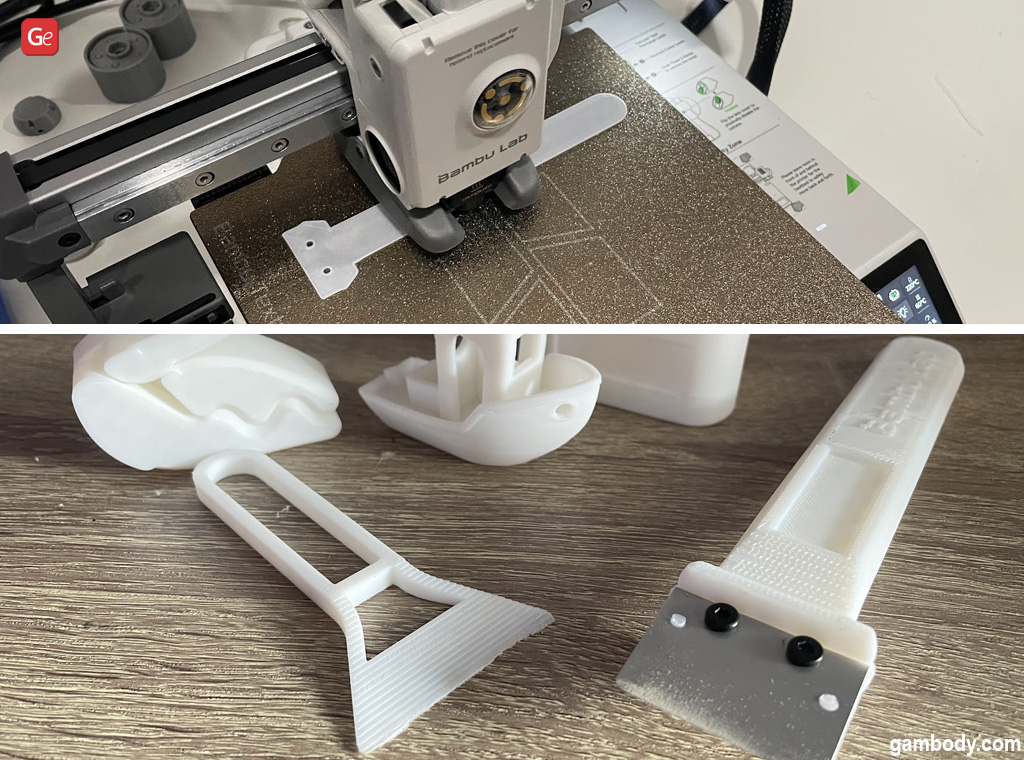
Bambu Lab Mobile and Desktop Apps
Hobbyists who choose a Bambu printer for their home projects should consider the company’s mobile and desktop apps, Bambu Handy and Bambu Studio.
Bambu Handy
Bambu Lab printers are very closely connected to smartphones and computers. Literally, as soon as you turn on Bambu Lab A1, this mini machine requests to be connected to the Wi-Fi network. Then, you are asked to scan the QR code from the mobile application, adding the Bambu A1 mini to your account.
The company released an assistant application called Bambu Handy (Hello, Mr. Handy!), which helps you monitor all basic processes and control your 3D printer. You can do this from anywhere in the world as long as the Bambu Lab A1 mini 3D printer is connected to your network.
The Bambu Handy app is divided into 3 sections and has a social component:
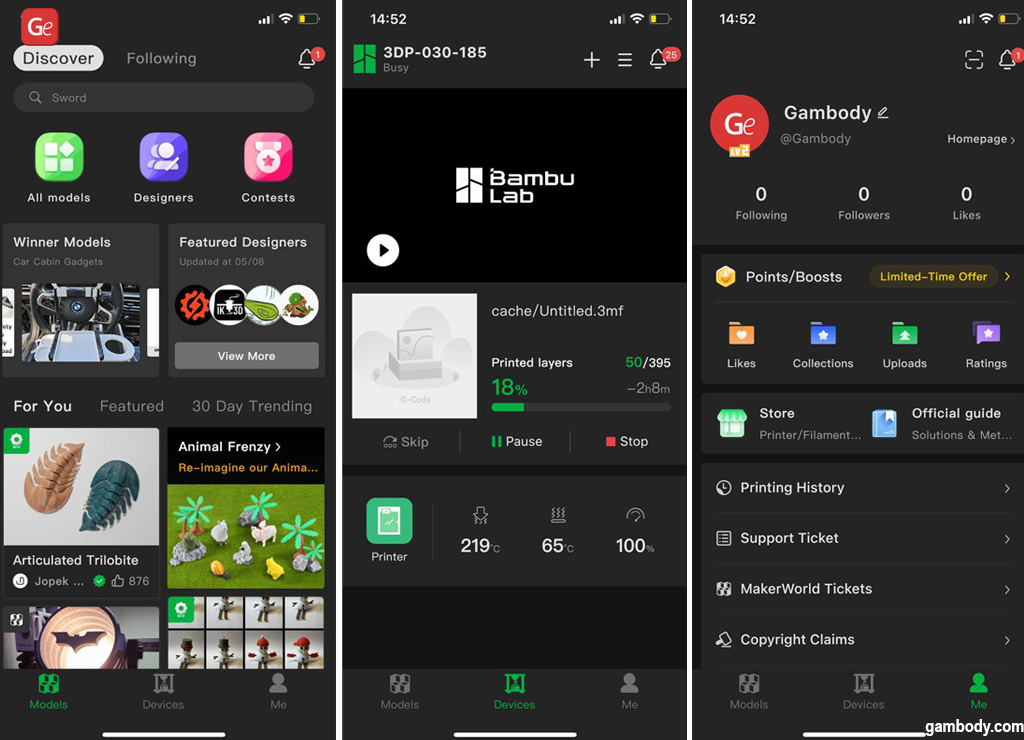
- The first section is dedicated to the internal free platform where anyone can upload their 3D printing files, with or without AMS system support. There are not very many models on this platform yet, but you can find some interesting projects to 3D print. The models are divided into two categories: technical (projects that complement your Bambu 3D printer, such as a plastic bin or a key holder) and toy.
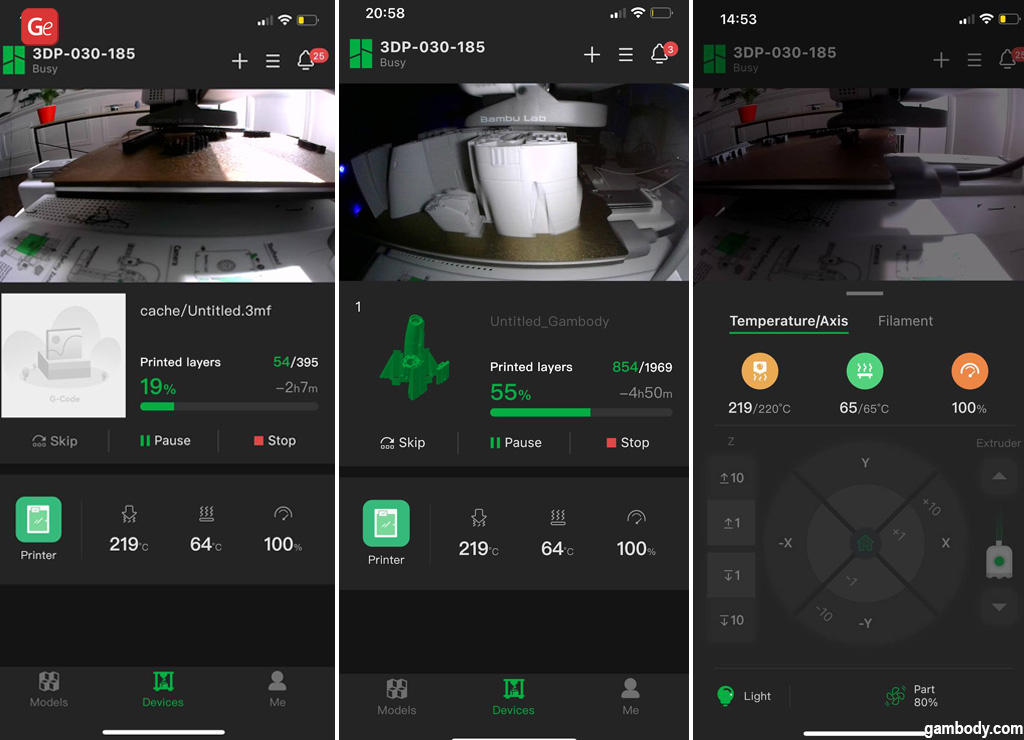
- The second section is dedicated specifically to your connection to A1 mini. Here you can see the main configurations, such as the nozzle or bed temperature and print speed. You can also access your Bambu Lab printer control menu. At the top of the screen, there is a space for displaying images from your camera, which has lights for easier monitoring of the 3D printing process even at night (you can turn off the backlight and shut the camera). It’s incredible as you can always check if everything is fine, speed up or slow down the printing, move the printhead, etc. When A1 mini finishes printing, you will receive a notification on your smartphone app. Even this one wonderful feature makes you want to order a Bambu Lab 3D printer at once!
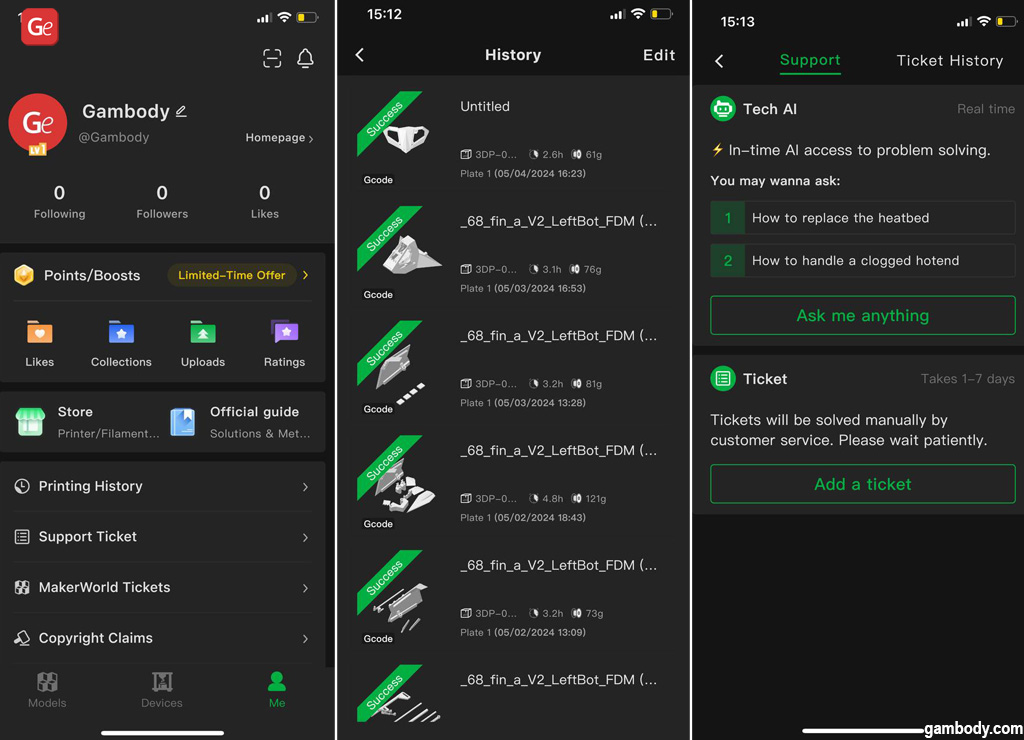
- The third section is social. Here, you can find your profile photo, subscribers, and the models you uploaded. You can also access the history of your 3D printing on A1 mini Bambu, the filament used, and the success or failure of the prints. Also, you can see all your requests to the Customer Support Center and their process. Bambu Lab awards you with points, which increase your level with every task you complete, such as loading your 3D printing files, etc.
Bambu Studio
Bambu Lab releases its 3D printers with their own slicer, Bambu Studio. Many users have already called it the best slicer on the market. Let’s see if they have a point!
Bambu Studio has an eye-pleasing green interface with a calming effect. This interface reminds me of Prusa Slicer, which, as we’ll soon find out, is built using the same engine. I consider this a good thing because Prusa Slicer has recently developed a more intelligible G-code and is more convenient to use than Ultimaker Cura.
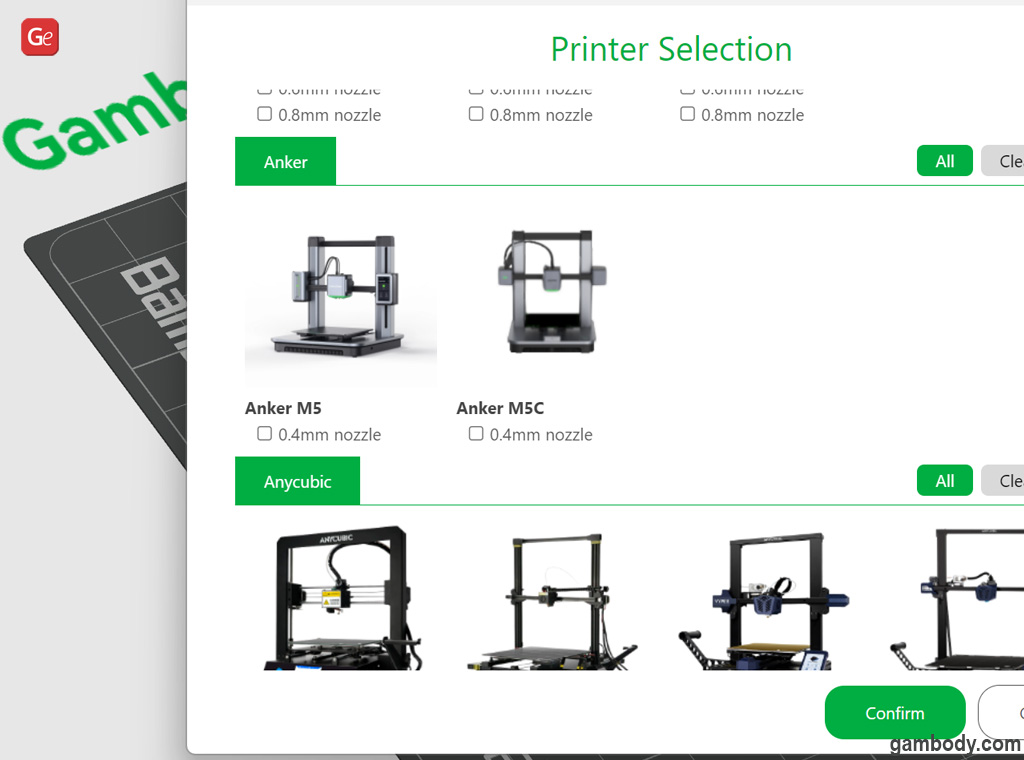
Bambu Lab slicer works with the company’s branded 3D printers, such as A1 mini, and also supports third-party manufacturers, which is definitely a big plus. In addition, you can add and configure your own printer.
Bambu Studio interface has several menu settings, including Prepare, Preview, Device, Project, and Calibration. Let’s take a quick look at each one.
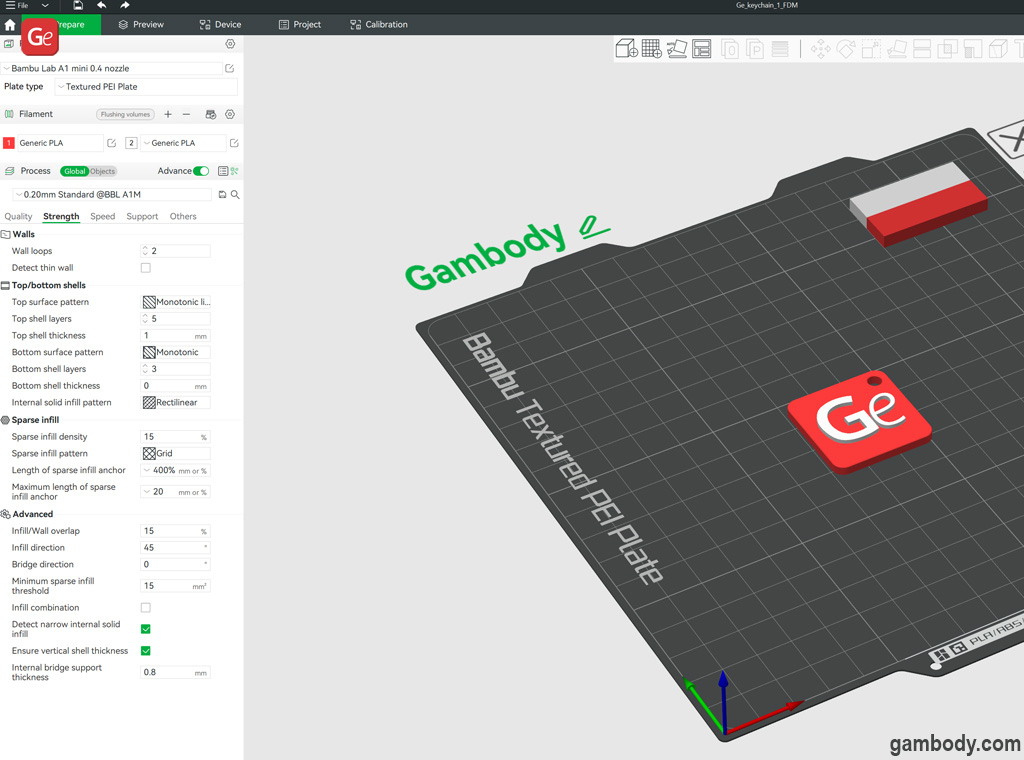
- Prepare contains the basic printing settings for wall thickness, layer height, speed, supports, and filament-dedicated settings (color, type, printing temperature). Bambu Lab engineers have already adjusted all these parameters for your Bambu 3D printer, which is fantastic because they work great! There are even several layer height presets. As for third-party 3D printers, Gambody will provide our 3D printing recommendations soon. Please follow the updates on gambody.com.
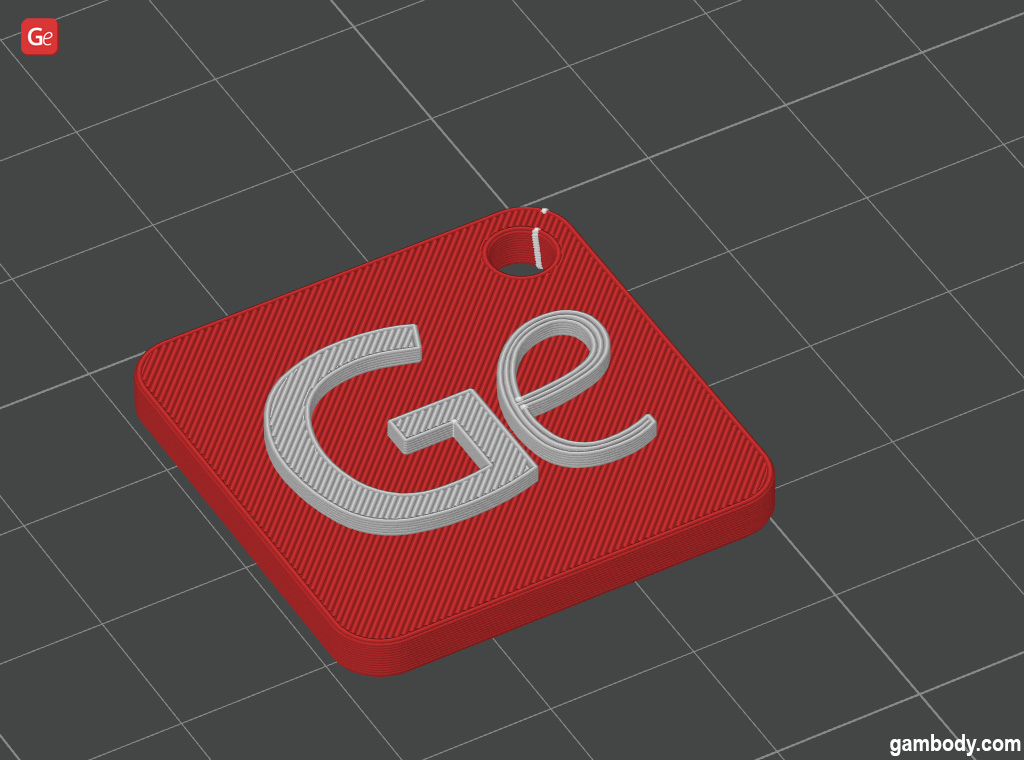
- Preview shows how the model will be 3D printed, including its filling, seam location, support placement, and much more. The 3D printing files are sent over the network directly to Bambu Lab A1 mini. I never had to use a flash drive. Even though we’ve seen this before, Bambu Lab made this process truly convenient and intuitive.
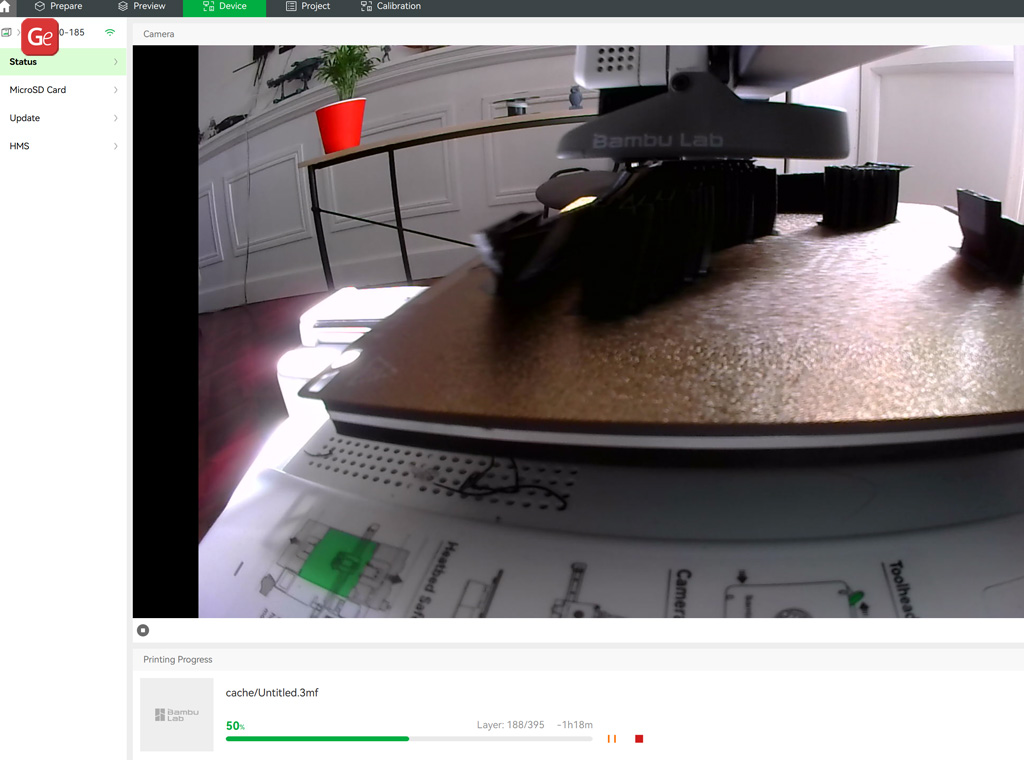
- Device helps you manage and monitor your A1 mini 3D printer. The biggest part of the screen shows your camera image, and to the right, you can see the 3D printer control menu. Here you can adjust the printing temperature slightly or send the Bambu mini to its home position. The bottom portion of the screen shows the 3D printing progress, printing time, and an option to pause or stop the print. On the left, you can view the 3D printing files on your card and update your Bambu Lab printer to the latest firmware version.
- Project allows you to manage your project. We’ll return to this section later in our Bambu Lab A1 mini review.
- Calibration is about A1 mini calibration. This section provides information about calibration and lets you calibrate your Bambu Lab 3D printer.
Overall, the Bambu Studio slicer is worth your attention. It looks great and functional. The only question you might have if you are used to Ultimaker Cura is where to look for the temperature settings. It might sound unusual, but Bambu Studio offers these settings under Filament instead of 3D printer settings.
Maker World
As mentioned above, Bambu Lab has its own platform on which all users can post the 3D printing models they have modeled. All the models are 100% free, but the company rewards users with coins for each upload they make, and you can use these coins as a discount when purchasing some products on Bambu Lab website.
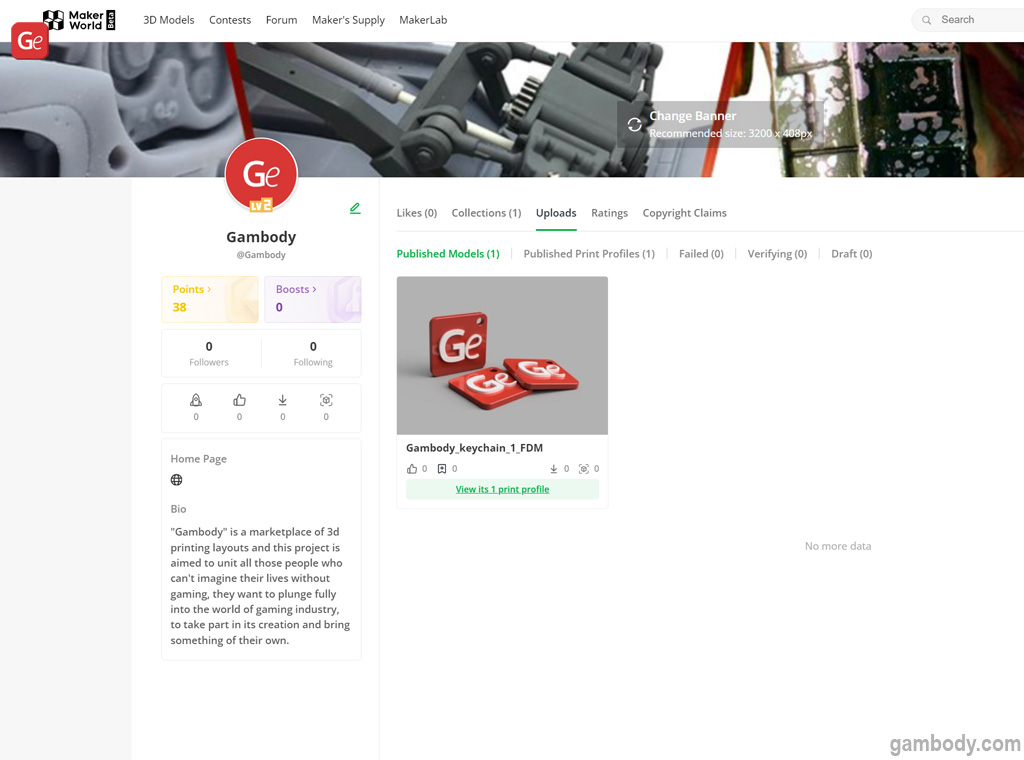
Maker World supports STL and 3mf files. Please note that Bambu Studio has its own 3mf format, and anyone wishing to open a pre-colored file must save the colored project in Bambu Studio, which is inconvenient. I hope that this issue will be fixed in the future and that 3mf will become versatile, replacing STL files.
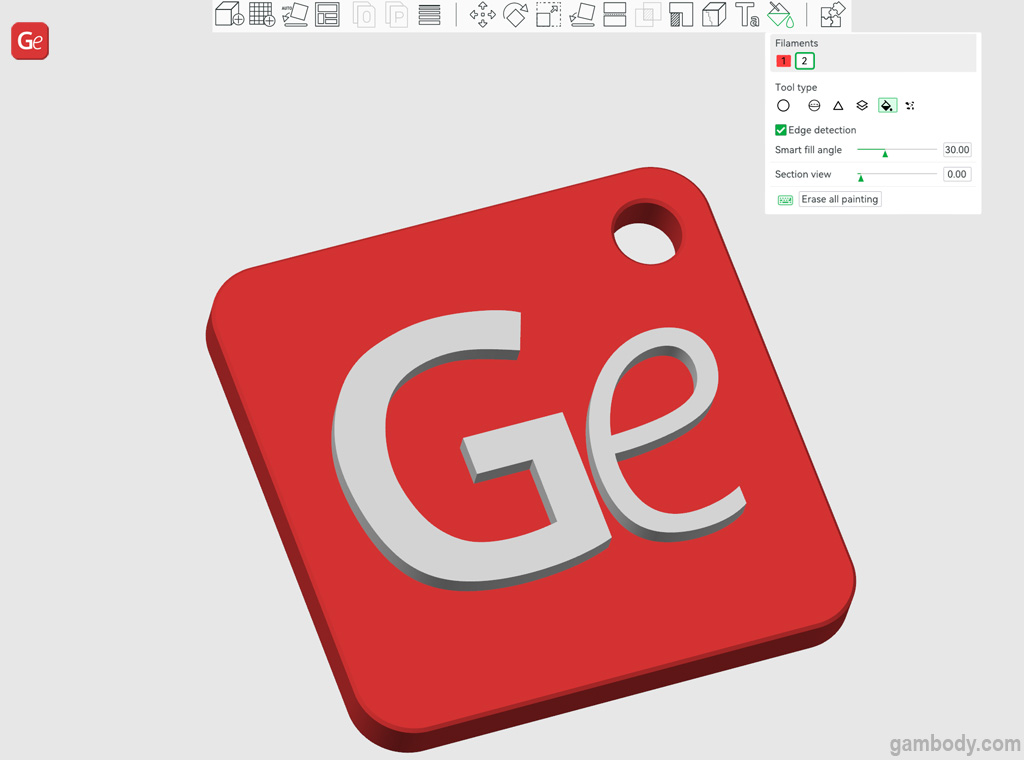
It is easy to choose filament colors for your models using Bambu Studio. The slicer offers smart fill, thus, all you need is the correct polygonal mesh of your 3D model. Gambody.com offers 3D printing projects mostly with the correct polygonal mesh, especially for spaceships, vehicles, and robots. However, if you plan to 3D print models from Gambody 3D printing marketplace with multi-colored filament, we recommend you consult our customer support regarding the compatibility of a particular 3D model with multi-color printing and filling in Bambu Studio.
Read also: 7 Methods of How to 3D Print 2 Colours with 1 Extruder
Using Maker World by Bambu Lab, you can upload your 3D model and add its description, images, and printing settings (optional). This way, you can earn awards.
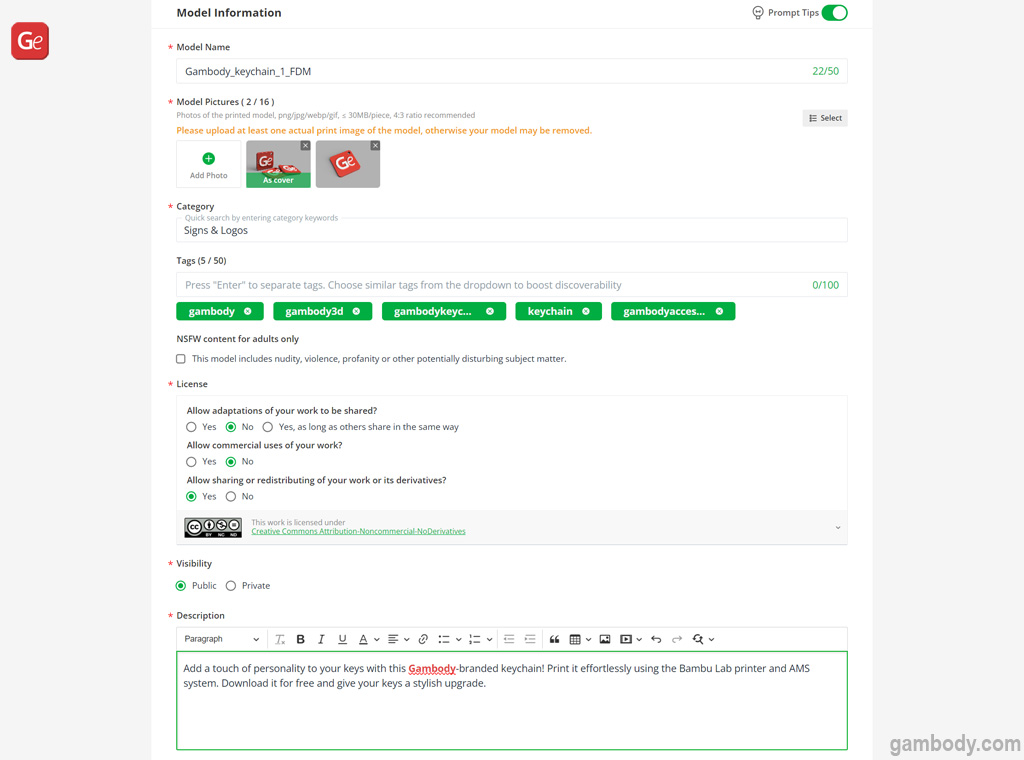
After this, your 3D model is published on the platform and anyone can download it. We uploaded an exclusive free Gambody-branded keychain to Maker World as a test. Using your Bambu 3D printer and the AMS system, you can give your keys a new look and feel a little closer to us!
Bambu Lab A1 Mini Testing
We chose one of the newest models on Gambody 3D printing marketplace, the F-14 Tomcat model from the cult movie TOPGUN, to test the Bambu A1 mini. David Richardson designed this iconic aircraft model. Although he is new to our marketplace, David considered all our recommendations on how to upload 3D printing models on Gambody and earn money while creating this beautiful model.
The F-14 Tomcat is of medium complexity, boasting elements such as a thin cabin frame, a thin empennage, and a delicate chassis. It is perfect for testing A1 mini. As already mentioned, do not underestimate the size of the Bambu Lab A1 Mini 3D printer bed, as most 3D printing models on gambody.com are designed specifically for these dimensions.
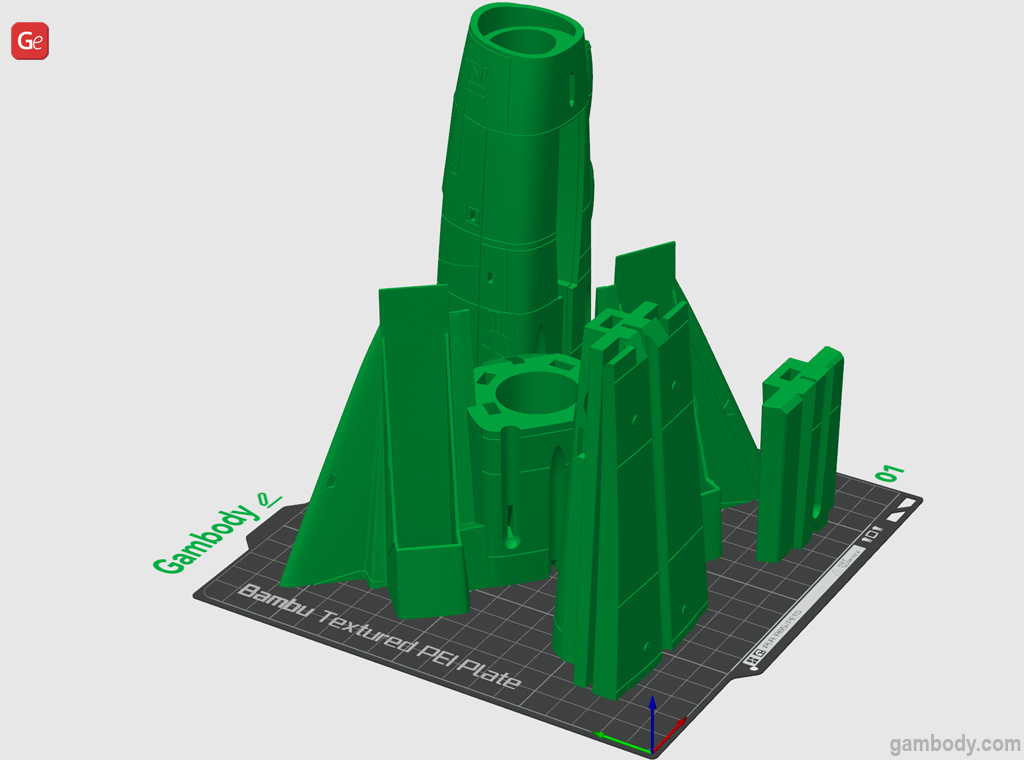
We placed several F-14 parts on the A1 mini Bambu bed at once and didn’t use the brim at all. We blocked some supports and added more support structures in some areas to strengthen them. We chose the minimal 5% infill and three walls.
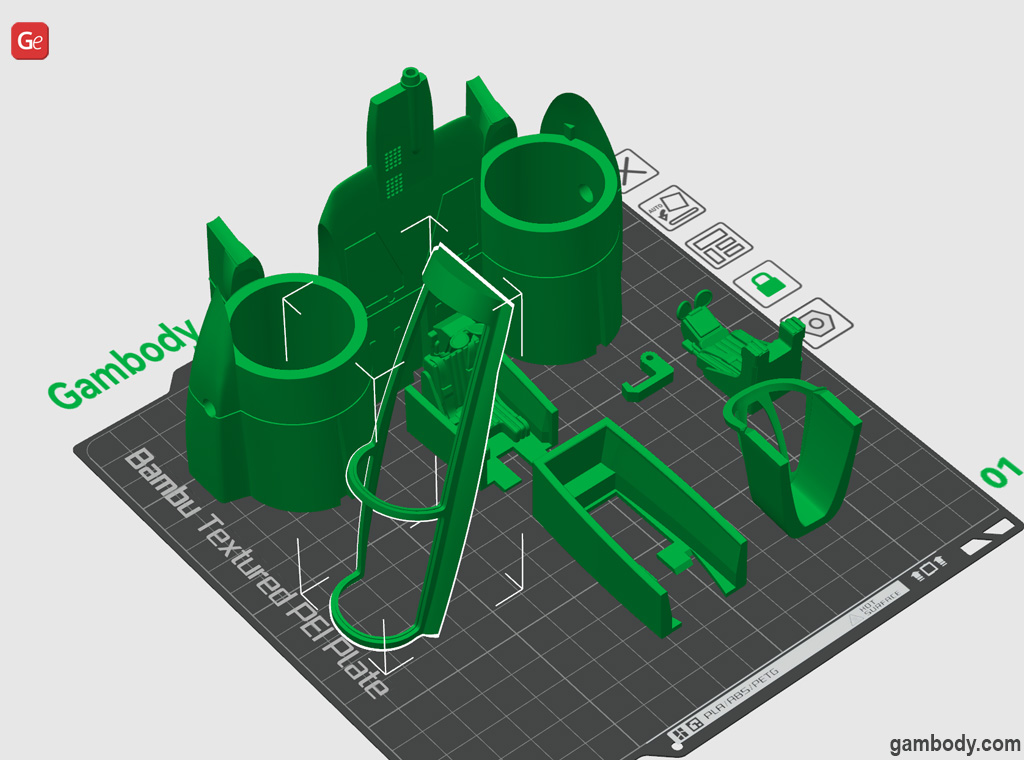
The final result impressed us a lot.
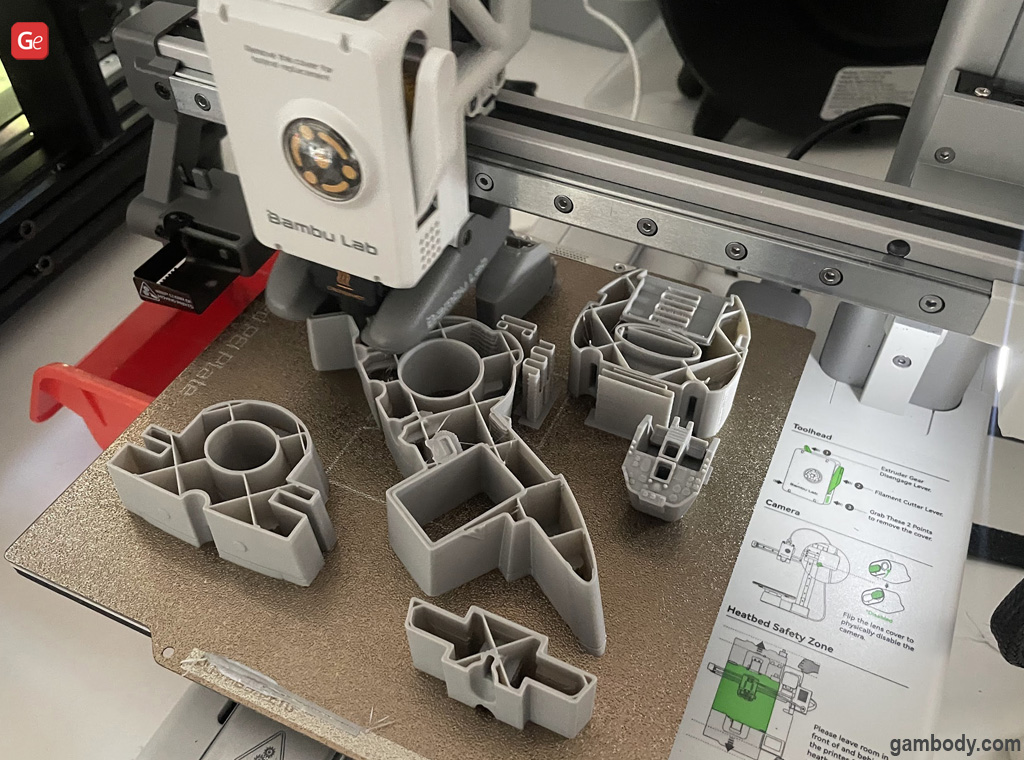
Bambu Lab A1 print quality is incredible, considering the superfast speeds. Bambu 3D printer is very quiet, even if you don’t enable Silent Mode, which reduces the noise and speed by 50%. The parts stay on the bed even without the brim. We didn’t adjust the default settings. The slicer slows down while printing the small parts, increasing the drying time of each layer. It does the same when working on the steep overhang angles. There are no webs from retracts at all. Bambu Lab’s most affordable 3D printer is fantastic!
Once all F-14 parts are 3D printed, it’s time to assemble them with glue and paint with silver paint. You can also print with silver plastic and leave that beautiful gray color!
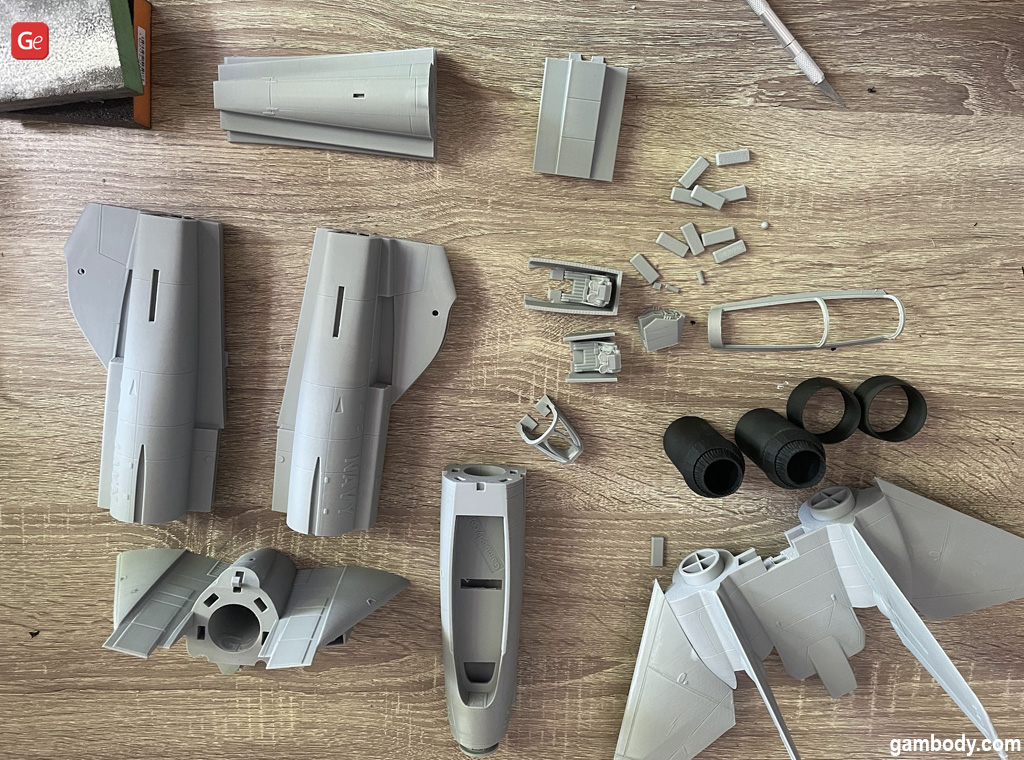
Bambu Lab Mini Final Score
| A1 mini Pros | Neutral | Bambu A1 mini Cons | Score |
| Magnetic PEI plate | +1 | ||
| Price | +1 | ||
| Standard kit | 0 | ||
| The print area is smaller than usual | -0.5 | ||
| Quiet operation, especially in Silent Mode | +1 | ||
| Print quality | +2 | ||
| Design | +1.5 | ||
| Fixed bed with auto-leveling system and precise calibration | +1.5 | ||
| Possibility of 3D printing with multi-colored filament | +1 | ||
| Great build quality | +1.5 | ||
| Easy to assemble | +1.5 | ||
| Screen | 0 | ||
| Interface | +1.5 | ||
| Performance | +1 | ||
| Intelligent Direct Extruder | +1 | ||
| Quick-release nozzles | +1 | ||
| Great nozzle fan | +1 | ||
| Camera | +1 | ||
| Bambu Lab slicer with precise settings (Bambu Studio) | +1 | ||
| Bambu Lab mobile app (Bambu Handy) | +1 |
The Bambu Lab A1 Mini combines many great features, such as a lovely design, high print speed, excellent print quality, and an affordable price. It is also part of an exclusive ecosystem built around this 3D printer by Bambu Lab, which includes branded filaments, a slicer, a platform for uploading 3D models, a mobile and desktop application, and much more.
You can use Bambu A1 mini as your main 3D printer for great 3D printing adventures, placing it on your desk (the machine requires little space, can print most models from gambody.com, and won’t disturb you with its noise). You can also use the A1 mini 3D printer as an essential assistant to a larger Bambu Lab A1 or X1. There can never be too many 3D printers, can’t it? If you are unsure if you need the AMS system, you can order the A1 mini without it and purchase AMS later.
This Bambu Lab 3D printer has no drawbacks. On the contrary, it is several steps ahead of its competitors. The only thing I could highlight is that it is impossible to slow down A1 mini by more than 50% during 3D printing, and I would be happy to return to the percentage setting offered by other manufacturers in the past (at least within the web interface).
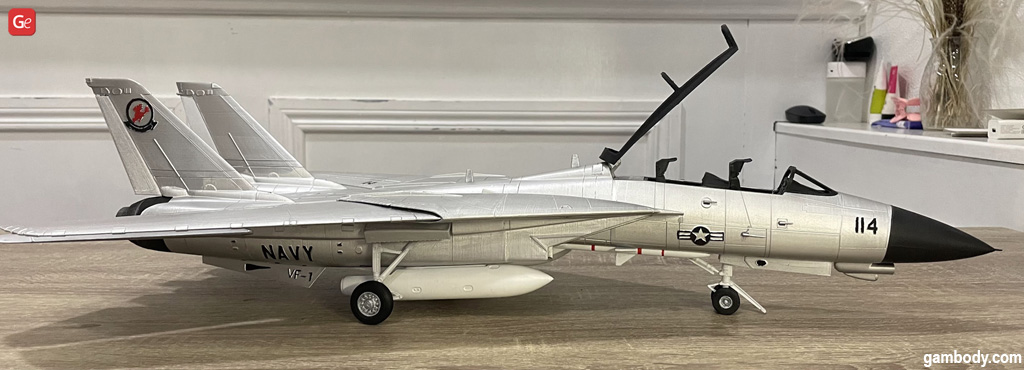
I am very impressed with the camera in a $250 A1 mini 3D printer! All the great solutions implemented by engineers in this Bambu printer are fantastic for the price. The A1 mini requires no assembly. It works straight out of the box. Regular software updates from Bambu Lab and the addition of new features will make you happy.
In my humble opinion, the Bambu Lab A1 mini is the cutest 3D printer in the entire line. I like it the most for its compact size and design. I can easily place it, for example, on the armrest of my couch.
Author: The Chair of the Engineering Department (Gambody)


